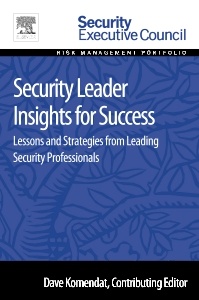Description
Security Leader Insights for Success
Lessons and Strategies from Leading Security Professionals
Coordinator: Komendat Dave
Language: English
Subject for Security Leader Insights for Success:
140 p. · 15x22.8 cm · Paperback
Description
/li>Contents
/li>Biography
/li>Comment
/li>
How do you, as a busy security executive or manager, stay current with evolving issues, familiarize yourself with the successful practices of your peers, and transfer this information to build a knowledgeable, skilled workforce the times now demand? With Security Leader Insights for Success, a collection of timeless leadership best practices featuring insights from some of the nation?s most successful security practitioners, you can.
This book can be used as a quick and effective resource to bring your security staff up to speed on leadership issues. Instead of re-inventing the wheel when faced with a new challenge, these proven practices and principles will allow you to execute with confidence knowing that your peers have done so with success.
Security Leader Insights for Success is a part of Elsevier?s Security Executive Council Risk Management Portfolio, a collection of real world solutions and "how-to" guidelines that equip executives, practitioners, and educators with proven information for successful security and risk management programs.
Introduction
Part 1: The Skills Needed for Successful Security Leadership
1. The Art of Leadership Experienced corporate security executives share some of the secrets to their success and the resources they relied on to get there.
2. Be the Great Motivator Learn to motivate and engage your staff so they will be more likely to want to work with you to better security.
3. Becoming a Business Leader If everyone in security acts like a leader, the security program will achieve greater success and better alignment with business goals.
4. Finding Time: Time Management Strategies for the Busy Security Leader Keep your sanity while getting it all done with these time management tools and tricks.
5. Leading Up: Or, How to Build a Positive Relationship with Your Manager Strong leadership isn’t just about how you relate to the people below you on the reporting ladder: it’s also about how you relate to those above.
6. Understanding Your Corporate Culture Don’t underestimate the effects a new security measure will have on your corporate culture.
7. Rebuilding Influence after Corporate Restructuring Learn how to rebuild security’s influence after a business reorganization with these essential strategies.
8. Managing Expectations Experienced security professionals share best practices for managing the expectations of senior management.
9. Running Security like a Business Help improve the business bottom line by aligning the security program with business needs and goals.
10. Becoming a Next Generation Security Leader Get a little closer to realizing your future career with these strategies and best practices for Next Generation Security Leadership.
Part 2: Building Your Toolkit
11. Developing Meaningful Security Metrics Experienced practitioners explain how to deliver meaningful metrics that are used to inform management and improve security effectiveness.
12. Setting Realistic Goals that Align with Business Interests Learn how to recognize if your organization is ready to buy-in to security’s strategic plan—before you try to implement it.
13. The New Security Assessment Ensure management will act upon your recommendations with these tips for conducting and presenting a security assessment.
14. Expect the Best: Evaluating Your Security Staff Guarantee your security staff are the best-in-class with these proven employee evaluation guidelines.
15. Business Evolution Requires Active Security Alignment Experienced security professionals share strategies for ensuring that security is aligned with the business’s structure, goals, and strategies.
16. Emerging Issue Awareness One veteran security professional discusses the value of emerging issue awareness, its challenges, and tips for staying aware.
17. Planning for Change Effective strategic planning tips from experienced security practitioners for security and risk management leaders.
18. Reinventing Security Learn how to overhaul your security department following a drastic organizational change or due to functional flaw with these lessons in reinventing security.
Part 3: Looking Forward
19. Security’s Role in Corporate Social Responsibility Planning strategies for security leaders being asked to run corporate social responsibility (CSR) programs.
20. Advances and Stalemates in Security Reflections on how security leaders have made recent advancements, and where they seem to have hit a wall.
21. Addressing the Knowledge Transfer Gap Begin to think about how to pass on your accumulated strategic security knowledge to your peers, staff, or successors with these ideas for a new kind of training program.
22. Eleven Ways to Encourage Strategic Thinking Boost the strategic thinking and planning skills of your direct reports by encouraging them to take on these 11 key strategic areas.
23. Risk at High Velocity Strategies for preparing nimble, resourceful, and creative security solutions that match the speed of new kinds of threats and risks security faces.
24. What Will Security Look like in 2020? Risk strategy guidelines for the ever-evolving and complex nature of business, and predictions for what security could be in the year 2020.
- Each chapter can be read in five minutes or less, and is written by or contains insights from experienced security leaders.
- Can be used to find illustrations and examples you can use to deal with a relevant issue.
- Brings together the diverse experiences of proven security leaders in one easy-to-read resource.




